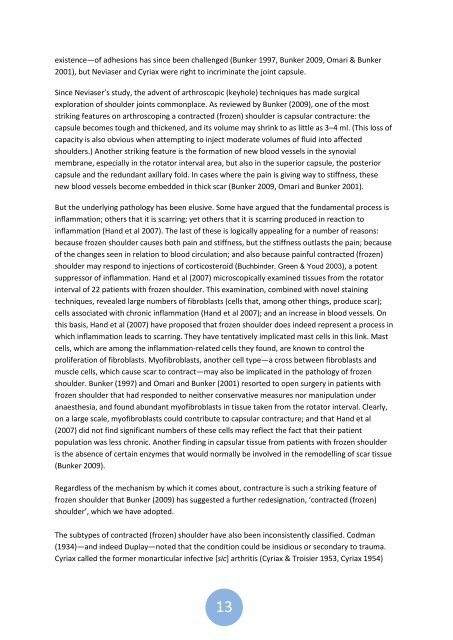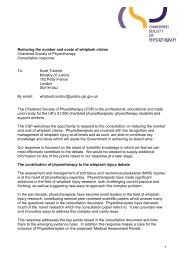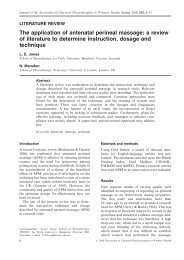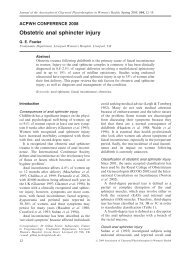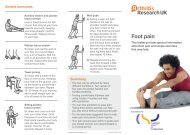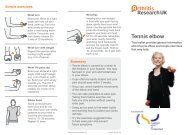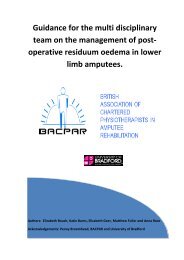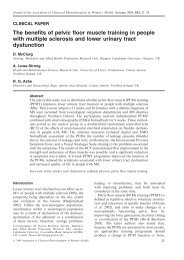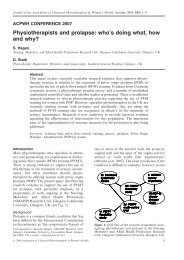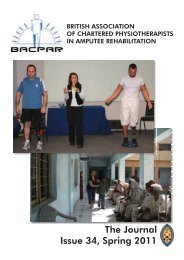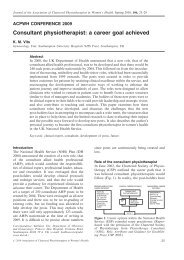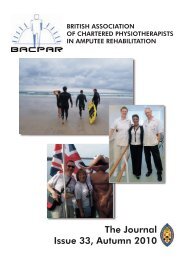here - The Chartered Society of Physiotherapy
here - The Chartered Society of Physiotherapy
here - The Chartered Society of Physiotherapy
You also want an ePaper? Increase the reach of your titles
YUMPU automatically turns print PDFs into web optimized ePapers that Google loves.
existence—<strong>of</strong> adhesions has since been challenged (Bunker 1997, Bunker 2009, Omari & Bunker<br />
2001), but Neviaser and Cyriax were right to incriminate the joint capsule.<br />
Since Neviaser’s study, the advent <strong>of</strong> arthroscopic (keyhole) techniques has made surgical<br />
exploration <strong>of</strong> shoulder joints commonplace. As reviewed by Bunker (2009), one <strong>of</strong> the most<br />
striking features on arthroscoping a contracted (frozen) shoulder is capsular contracture: the<br />
capsule becomes tough and thickened, and its volume may shrink to as little as 3–4 ml. (This loss <strong>of</strong><br />
capacity is also obvious when attempting to inject moderate volumes <strong>of</strong> fluid into affected<br />
shoulders.) Another striking feature is the formation <strong>of</strong> new blood vessels in the synovial<br />
membrane, especially in the rotator interval area, but also in the superior capsule, the posterior<br />
capsule and the redundant axillary fold. In cases w<strong>here</strong> the pain is giving way to stiffness, these<br />
new blood vessels become embedded in thick scar (Bunker 2009, Omari and Bunker 2001).<br />
But the underlying pathology has been elusive. Some have argued that the fundamental process is<br />
inflammation; others that it is scarring; yet others that it is scarring produced in reaction to<br />
inflammation (Hand et al 2007). <strong>The</strong> last <strong>of</strong> these is logically appealing for a number <strong>of</strong> reasons:<br />
because frozen shoulder causes both pain and stiffness, but the stiffness outlasts the pain; because<br />
<strong>of</strong> the changes seen in relation to blood circulation; and also because painful contracted (frozen)<br />
shoulder may respond to injections <strong>of</strong> corticosteroid (Buchbinder, Green & Youd 2003), a potent<br />
suppressor <strong>of</strong> inflammation. Hand et al (2007) microscopically examined tissues from the rotator<br />
interval <strong>of</strong> 22 patients with frozen shoulder. This examination, combined with novel staining<br />
techniques, revealed large numbers <strong>of</strong> fibroblasts (cells that, among other things, produce scar);<br />
cells associated with chronic inflammation (Hand et al 2007); and an increase in blood vessels. On<br />
this basis, Hand et al (2007) have proposed that frozen shoulder does indeed represent a process in<br />
which inflammation leads to scarring. <strong>The</strong>y have tentatively implicated mast cells in this link. Mast<br />
cells, which are among the inflammation-related cells they found, are known to control the<br />
proliferation <strong>of</strong> fibroblasts. My<strong>of</strong>ibroblasts, another cell type—a cross between fibroblasts and<br />
muscle cells, which cause scar to contract—may also be implicated in the pathology <strong>of</strong> frozen<br />
shoulder. Bunker (1997) and Omari and Bunker (2001) resorted to open surgery in patients with<br />
frozen shoulder that had responded to neither conservative measures nor manipulation under<br />
anaesthesia, and found abundant my<strong>of</strong>ibroblasts in tissue taken from the rotator interval. Clearly,<br />
on a large scale, my<strong>of</strong>ibroblasts could contribute to capsular contracture; and that Hand et al<br />
(2007) did not find significant numbers <strong>of</strong> these cells may reflect the fact that their patient<br />
population was less chronic. Another finding in capsular tissue from patients with frozen shoulder<br />
is the absence <strong>of</strong> certain enzymes that would normally be involved in the remodelling <strong>of</strong> scar tissue<br />
(Bunker 2009).<br />
Regardless <strong>of</strong> the mechanism by which it comes about, contracture is such a striking feature <strong>of</strong><br />
frozen shoulder that Bunker (2009) has suggested a further redesignation, ‘contracted (frozen)<br />
shoulder’, which we have adopted.<br />
<strong>The</strong> subtypes <strong>of</strong> contracted (frozen) shoulder have also been inconsistently classified. Codman<br />
(1934)—and indeed Duplay—noted that the condition could be insidious or secondary to trauma.<br />
Cyriax called the former monarticular infective [sic] arthritis (Cyriax & Troisier 1953, Cyriax 1954)<br />
13


